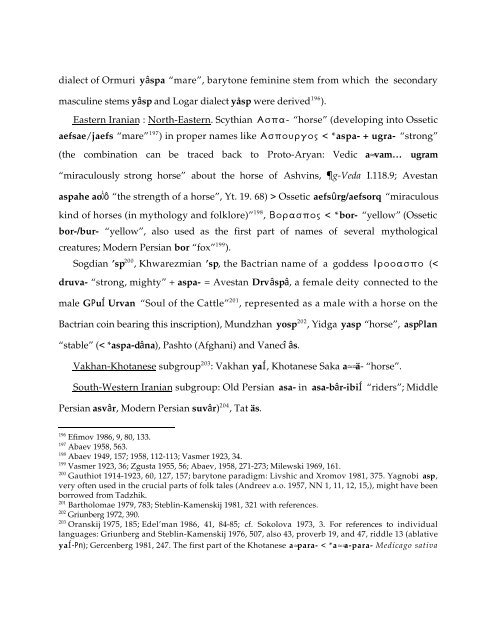Comparative Notes on Hurro-Urartian, Northern Caucasian
Comparative Notes on Hurro-Urartian, Northern Caucasian
Comparative Notes on Hurro-Urartian, Northern Caucasian
Create successful ePaper yourself
Turn your PDF publications into a flip-book with our unique Google optimized e-Paper software.
dialect of Ormuri yâspa “mare”, baryt<strong>on</strong>e feminine stem from which the sec<strong>on</strong>dary<br />
masculine stems yâsp and Logar dialect yåsp were derived 196 ).<br />
Eastern Iranian : North-Eastern. Scythian Aspa- “horse” (developing into Ossetic<br />
aefsae/jaefs “mare” 197 ) in proper names like Aspourgow < *aspa- + ugra- “str<strong>on</strong>g”<br />
(the combinati<strong>on</strong> can be traced back to Proto-Aryan: Vedic a≈vam… ugram<br />
“miraculously str<strong>on</strong>g horse” about the horse of Ashvins, g-Veda I.118.9; Avestan<br />
aspahe aoÔô “the strength of a horse”, Yt. 19. 68) > Ossetic aefsûr /aefsorq “miraculous<br />
kind of horses (in mythology and folklore)” 198 , Boraspow < *bor- “yellow” (Ossetic<br />
bor-/bur- “yellow”, also used as the first part of names of several mythological<br />
creatures; Modern Persian bor “fox” 199 ).<br />
Sogdian ’sp 200 , Khwarezmian ’sp, the Bactrian name of a goddess Irooaspo (<<br />
druva- “str<strong>on</strong>g, mighty” + aspa- = Avestan Drvâspâ, a female deity c<strong>on</strong>nected to the<br />
male GPuÍ Urvan “Soul of the Cattle” 201 , represented as a male with a horse <strong>on</strong> the<br />
Bactrian coin bearing this inscripti<strong>on</strong>), Mundzhan yosp 202 , Yidga yasp “horse”, aspPlan<br />
“stable” (< *aspa-dâna), Pashto (Afghani) and Vanecî âs.<br />
Vakhan-Khotanese subgroup 203 : Vakhan yaÍ, Khotanese Saka a≈≈ä- “horse”.<br />
South-Western Iranian subgroup: Old Persian asa- in asa-bâr-ibiÍ “riders”; Middle<br />
Persian asvâr, Modern Persian suvâr) 204 , Tat äs.<br />
196 Efimov 1986, 9, 80, 133.<br />
197 Abaev 1958, 563.<br />
198 Abaev 1949, 157; 1958, 112-113; Vasmer 1923, 34.<br />
199 Vasmer 1923, 36; Zgusta 1955, 56; Abaev, 1958, 271-273; Milewski 1969, 161.<br />
200 Gauthiot 1914-1923, 60, 127, 157; baryt<strong>on</strong>e paradigm: Livshic and Xromov 1981, 375. Yagnobi asp,<br />
very often used in the crucial parts of folk tales (Andreev a.o. 1957, NN 1, 11, 12, 15,), might have been<br />
borrowed from Tadzhik.<br />
201 Bartholomae 1979, 783; Steblin-Kamenskij 1981, 321 with references.<br />
202 Griunberg 1972, 390.<br />
203 Oranskij 1975, 185; Edel’man 1986, 41, 84-85; cf. Sokolova 1973, 3. For references to individual<br />
languages: Griunberg and Steblin-Kamenskij 1976, 507, also 43, proverb 19, and 47, riddle 13 (ablative<br />
yaÍ-Pn); Gercenberg 1981, 247. The first part of the Khotanese a≈para- < *a≈≈a-para- Medicago sativa





